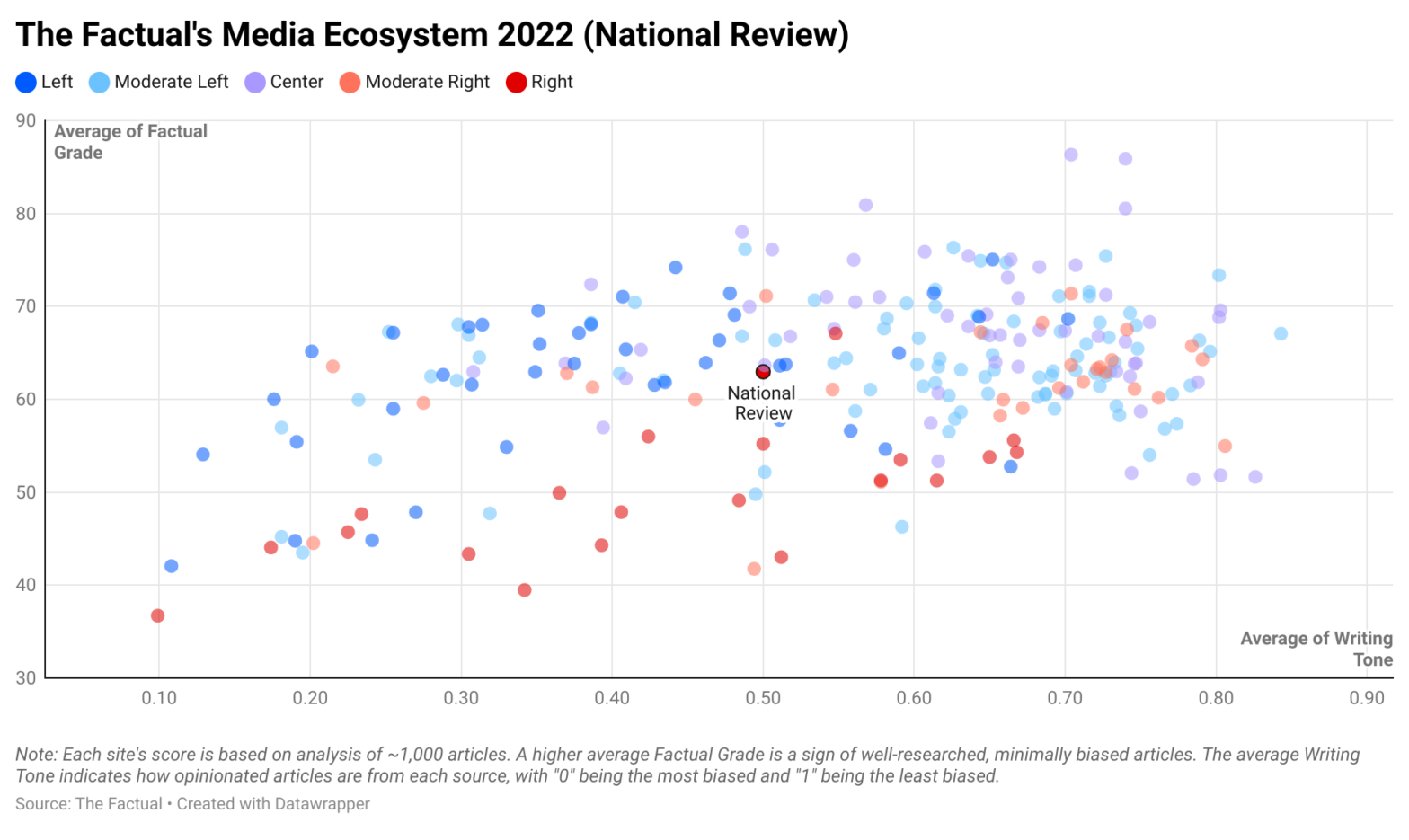Once called the “bible of American conservatism,” the National Review is often credited with being a uniting force for conservative thought in the second half of the 20th century. Today, it remains a consequential forum for conservative thought, including tensions and overlap between traditional conservatism, neoconservatism, the populist right, and libertarianism. But the site has also been the subject of some controversy, from problematic contributors to contradicting scientific consensus on climate change. So, how reliable of a news source is the National Review?
How Does The Factual Rate News Sources?
The Factual analyzes more than 10,000 news stories every day to help readers find the most informative, least-biased articles. Our news-rating algorithm scores each article along four metrics: (1) cited sources and quotes, (2) publication history, (3) writing tone, and (4) author expertise. These scores combine in a weighted average we call a Factual Grade, which ranges from 0–100%. (See our How It Works page to learn more about our algorithm.)
For this study, we analyzed ~1,000 articles each from 240 news sources. The average Factual Grade for the entire dataset was 62.5%. Based on these averages, we can compare the performance of news sites across the media ecosystem. The entire dataset can be explored in greater detail here.
How Factual Is the National Review?
The National Review scored an average Factual Grade of 63.0%, placing it in the 45th percentile of our dataset. A mix of factors contribute to these average scores. The site does boast a wide range of authors, but these authors have varying degrees of topical expertise, suggesting only some cover the same topics regularly. Heavily opinionated language and headlines also drag scores downwards. Finally, articles tend to score poorly for cited evidence, meaning they rarely link to other relevant articles or do not always incorporate relevant quotations.
Like any news source, scores for articles from the National Review varied widely based on factors like author expertise and cited evidence. For example, some scored above 80%, while others scored below 50%.
Please check your email for instructions to ensure that the newsletter arrives in your inbox tomorrow.
How Opinionated Is the National Review?
One of the metrics The Factual uses is the Writing Tone, which measures how opinionated the writing is in an article. For this metric, the algorithm looks for signs of subjective commentary (e.g., first person pronouns and unnecessary adverbs), as well as the emotional nature of selected words, and sees how prevalent they are for a given length of text. More neutral text receives higher ratings, with “0” being the most opinionated and “1” being the most neutral.
The National Review had an average Writing Tone score of 0.50, placing it in the 32nd percentile in our dataset for this metric. This suggests that articles from the National Review often incorporate strongly opinionated language. This can be seen in headlines such as “Our Looming Procreative Anarchy” and “Trevor Noah Is a Moral Disgrace.”
What Is the National Review’s Political Bias?
The Factual classifies news sites by political bias as either Left, Moderate Left, Center, Moderate Right, or Right. This classification is derived from third-party assessments from media bias organizations such as AllSides and Media Bias/Fact Check. Based on this data, The Factual assigns the National Review a “Right” bias.
AllSides rates the National Review as “Right” based on an editorial review, a blind bias survey, and 28,129 community ratings. Though a blind bias survey in 2021 showed that readers were more likely to classify the site as “Lean Right,” an in-depth review by AllSides editors led to a “largely unanimous” decision to keep the site classified as “Right.” The editors acknowledged the site’s philosophy as from a “civic libertarian and constitutional/establishment conservative perspective, rather than a populist right perspective,” but also noted story selection that strongly favors the right. AllSides highlights that the National Review does not reflect the populist Right and has a tendency to criticize former president Trump.
Media Bias/Fact Check (MBFC) similarly classified the National Review as “Right,” due to “story selection that always favors the right.” They also give the site a “Mostly Factual” rating for information, noting a tendency to site less reliable sources such as PJ Media and the Daily Mail as well as multiple failed fact-checks. The National Review offers a combination of both pro- and anti-Trump coverage, ultimately slightly in favor of his administration, according to MBFC. Finally, MBFC warns about the frequent appearance of emotionally loaded wording in headlines.
Please check your email for instructions to ensure that the newsletter arrives in your inbox tomorrow.
Who Owns the National Review?
The National Review is owned by the National Review Institute, a non-profit organization dedicated to carry on the legacy of the magazine’s founder, William F. Buckley. The magazine’s principles accentuate fusionism — a mixture of traditionalist and social conservatism complemented by economic right-libertarianism. The magazine’s operations are largely supported by subscription fees, donations, and fundraisers.
Why Does It Matter?
News articles always have some bias because all authors have some frame of reference within which they describe a story. Political bias ratings are helpful in understanding this framing. However, it can be more beneficial to know how factual an article is based on quantifiable metrics that can be seen across the media ecosystem, such as cited evidence, author expertise, and writing tone. This is what The Factual ascertains.
Reading several, highly rated articles from across the political spectrum helps counter the bias of any news source or story. To have the day’s most factual news stories delivered to your inbox every morning, subscribe to our daily newsletter.
Article updated on September 19, 2022 to reflect new data.

